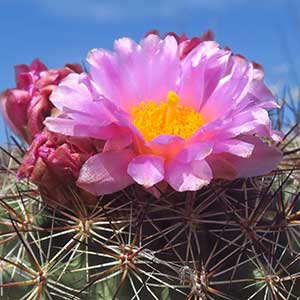Pediocactus nigrispinus
Pediocactus
black-spine snowball cactus, Columbia Plateau cactus, dark-spine ball cactus, snowball cactus
ball cactus, foot cactus, hedgehog cactus, pincushion cactus, plains cactus
appearing as taproots at soil surface, branching, and ultimately diffuse.
depressed-ovoid to elongate-ovoid, 5–30 × 5–15 cm;
areoles oval, villous.
unsegmented, green or gray-green, obconic-cylindric to spheric or depressed-spheric, 2–15 × 1–15 cm;
tubercles distinct, not confluent into ribs, pyramidal, conic, truncate-conic, cylindroid, or mammillate, 2–10 mm;
areoles circular, oval, pyriform, or elliptic, spiny and short or long woolly or glabrate;
areolar glands absent;
cortex and pith usually mucilaginous.
smooth, hard and rigid, distinguishable as radial and central;
radial spines 10–30 per areole, spreading at right angles to tubercles, nearly straight, white to dull reddish brown, 8–20 mm;
central spines 6–12 per areole, widely spreading or nearly erect, reddish brown to nearly black, rigid, straight or slightly curved, base yellow or cream, 15–35 mm, less than 1 mm diam. at base.
3–45, reddish tan, pink, gray, or white, needle-shaped or awl-shaped to hairlike, 6–30 × 0.3–1 mm, smooth and hard, less often corky or spongy and soft, finely puberulent to glabrous;
radial spines 3–35 per areole, spreading, erect, recurved, or somewhat pectinate, straight or irregularly curved, 1–32 mm;
central spines 0–12, straight or curved upward, needlelike, hairlike, or corky, terete to flat.
1–3.5 × 2.5–5 cm;
scales and outer tepals of flower tube minutely toothed, laciniate, or entire and undulate;
outer tepals with greenish brown midstripes, oblong-cuneate, 12–25 × 4.5–9 mm;
inner tepals white, pink, magenta, yellow, or yellow-green, 19–27 × 5–10 mm.
diurnal, borne at adaxial margins of areoles at stem apex, funnelform, 1–4 × 1–2.5 cm;
outer tepals greenish or purple midstripes, pink or yellow margins, 9–25 × 3–9 mm, margins fringed, denticulate, or entire;
inner tepals yellow, peach, pink, magenta, cream, or white, 4–15 × 3–7 mm, margins entire to fimbriate;
ovary smooth, scaleless to few scaled, spineless;
stigma lobes 5–9, yellow to green, 0.7–1.5 mm.
green tinged with red, drying reddish brown, short cylindric, 6–11 × 5–10 mm.
dehiscent along 1 vertical suture, green or greenish yellow, often turning reddish brown, thin walled, cylindric, spheric or turbinate, 4–15 × 3–11 mm, becoming dry at maturity, smooth, scaleless or with few broad, thin scales;
pulp greenish to white, scant;
floral remnant deciduous.
gray to black, 2–3 × 1.5–2 mm, papillate but not rugose.
brown, black or gray, irregularly or obliquely obovoid or pyriform, 1.5–5 × 1–3.5 × 1–1.5 mm, papillate, sometimes also rugose, shiny;
testa cells convex.
= 11.
Pediocactus nigrispinus
Pediocactus
No known morphologic character supports the taxonomic recognition of infraspecific taxa within Pediocactus nigrispinus. Characteristics used to distinguish the three described subspecies almost completely overlap. Pediocactus nigrispinus has been referred to P. simpsonii var. robustior (J. M. Coulter) L. D. Benson, which remains well within the range of variation for P. simpsonii. An unpublished study by J. M. Porter et al. of noncoding chloroplast DNA sequences shows P. simpsonii is less closely related to P. nigripsinus than to P. knowltonii, P. winkleri, and P. despainii.
(Discussion copyrighted by Flora of North America; reprinted with permission.)
Species 9 (9 in the flora).
Pediocactus is unified by its unusual fruit dehiscence and deciduous floral remnant. In other traits it is remarkably diverse. As a result, the nine species have historically been divided into as many as five genera. Chloroplast DNA sequences (R. Nyffeler 2002; C. A. Butterworth et al. 2002; J. M. Porter et al. unpublished) provide strong support for the monophyly of Pediocactus. Moreover, the traditional association of Pediocactus and Sclerocactus is refuted. Pediocactus is inferred to be more closely related to Glandulicactus, Turbinicarpus, and Ariocarpus, than to Sclerocactus, by these studies.
(Discussion copyrighted by Flora of North America; reprinted with permission.)
1. Spines corky or spongy; central or intermediate spines 1-1.5 mm diam. at base | P. peeblesianus |
1. Spines smooth, relatively hard, never corky or spongy; central spines, when present, 1 mm diam. at base or less | → 2 |
2. Outer tepals and scales of flower tube long-fringed; central spines long and stout, 13-30 mm; stems 5-25 cm; Arizona, Utah. | P. sileri |
2. Outer tepals and scales of flower tube either minutely toothed, laciniate, or entire and often undulate; central spines short and fine, less than 15 mm; or if spines stout and stem more than 5 cm, then not of Mojave and Coconino counties, Arizona, or Kane and Washington counties, Utah. | → 3 |
3. Central spines flexible, hairlike, twisting or curving irregularly (sometimes straight) | P. paradinei |
3. Central spines rigid, straight or slightly curved, sometimes absent | → 4 |
4. Stems 3-30 cm; central spines 4-12 per areole | → 5 |
4. Stems 0.7-6.8 cm; central spines 0(-2) per areole | → 6 |
5. Stems usually branched and elongate; spines nearly erect, radial spines reddish brown, 8-20 mm; usually below 1500 m; Washington, Oregon, and Idaho | P. nigrispinus |
5. Stems usually unbranched; spines spreading widely, radial spines white or cream, 3-13 mm; usually above 1500 m; Rocky Mountains and adjacent Great Plains of United States | P. simpsonii |
6. Stems 0.7-5.5 × 1-3 cm; radial spines 18-26 per areole; seeds papillate, but not rugose | P. knowltonii |
6. Stems 3.2-6.8 × 2.6-9.5 cm; radial spines 9-16 per areole; seeds papillate and rugose | → 7 |
7. Areoles elliptic; radial spines mostly 13-16 per areole; inner tepals cream to straw yellow; seeds brownish black | P. bradyi |
7. Areoles oval to nearly circular; radial spines mostly 9-15 per areole; inner tepals yellow-bronze, peach-bronze, or pink; seeds black or gray | → 8 |
8. Areoles mostly lanate (rarely glabrate); inner tepals peach or pink; seeds to 3 × 2 mm; plants s of San Rafael Swell, Utah | P. winkleri |
8. Areoles villous, not lanate; inner tepals yellow-bronze to peach bronze; seeds to 3.5 × 2.5 mm; plants of San Rafael Swell, Utah | P. despainii |


